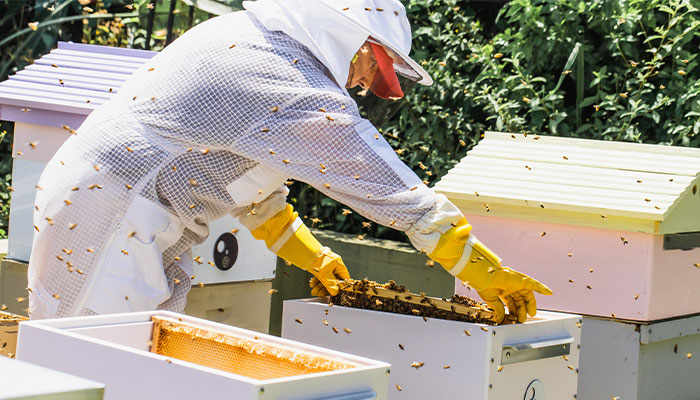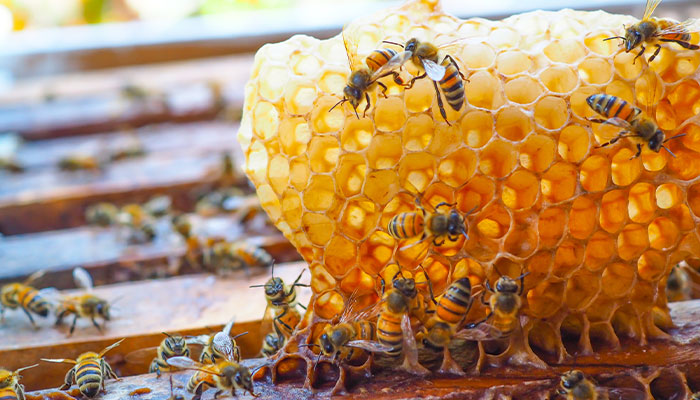Macquarie University’s Department of Biological Sciences has secured funding for a two-year pilot program aiming to support Australia’s dwindling honey bee population with automated early-warning systems for when hives are at risk.

Health check: Scientists are aiming to develop technology that can direct beekeepers' efforts to where they'll make the greatest impact.
Philanthropic organisation the Lord Mayor’s Charitable Foundation has awarded a $300,000 grant for the project that will test electronic sensors in hives that alert beekeepers to fluctuations in temperature which could indicate a decline in hive health.
Project lead Professor Andrew Barron said a robust early-warning signal that a hive is starting to struggle will give beekeepers the opportunity to intervene before it’s too late.
“The hope is that we'll find an easy-to-measure signal that reliably tells us when a colony is in trouble at the earliest possible point, so we can direct beekeepers’ efforts to where they'll make the greatest impact for the greatest benefit,” he said.
When a honeybee colony is under a lot of stress, it can actually look like it's doing OK until it's pushed right to the edge of collapse.
Monitoring bee health is difficult as there are very few indicators that a hive is at risk until it’s too late to salvage – however it is hoped that monitoring temperature through these inexpensive remote sensors could provide vital early red flags.
When a colony is healthy, bees maintain the hive temperature at 35°C – the ideal temperature for the bees and their larvae. But when colonies are struggling, temperature regulation – which bees manage through activities like fanning water droplets throughout the hive – becomes difficult.
Busy bees under stress
Australia’s bees are already under stress – about a third of food crops depend on bee pollination but there is a shortfall in the number of bees meeting demand. For example, 65 per cent of all bees in NSW are used for almond pollination alone, meaning that supply is short for other major crops including canola, carrot, apple, cherries and berries.

Hive mind: Identifying when a hive is in trouble early enough gives more options for intervention and rescue, says Professor Barron.
AgriFutures Australia estimates bee pollination to be worth $4 billion to $6 billion to the economy at current levels, with the number expected to grow as demand continues to increase.
On top of this shortfall are factors including pesticides, disease and climate change impacting bee numbers. The 2019-20 bushfires in NSW had a devastating impact on the state’s 250,000 hives – 10,000 were incinerated while another 90,000 lost their bee population due to the common response of bees abandoning a hive if fire or smoke is approaching.
- Please explain: Why are honey bees so important?
- Stress-busting tips for HSC students facing lockdown learning
It is hoped the pilot program will go someway towards supporting bee populations through giving beekeepers better tools to monitor hive health. That way beekeepers will be able to step in with appropriate help, such as treatment for diseases or moving the hive to where there is better access to food and water.
“Beekeepers are really good and skilful at intervening and strengthening colonies, and giving them what they need to be healthy,” says Professor Barron. “What we've realised though is that when a honeybee colony is under a lot of stress, it can actually look like it's doing OK until it's pushed right to the edge of collapse.
“If we can identify when a hive is in trouble early enough, we've got more options to have a beekeeper intervene and rescue that colony.”
Benefits to bees and their keepers
Professor Barron said the data from the project also has benefits in that manually inspecting hives by beekeepers is very labour intensive, including through individually checking frames, and it disrupts the bees.
An electronic system from a few cost-effective sensors will automatically report back alerts when a colony is vulnerable – allowing beekeepers to concentrate their efforts where they are urgently needed.
- Housing fever: New website takes temperature of runaway markets
- Please explain: What is seasonal affective disorder?
The project is set to begin in November and will run until October 2023. Stages will include measuring the temperatures of different states of hive health, developing the high-precision sensor system and then following with field trials. It is expected to be trialled across 50 hives in NSW.
The pilot program follows a five-year research project by the Department of Biological Sciences that used 'digital backpacks' or tiny digital chips attached to bees which monitored their movements and the effects of heat and stress.
Dr Andrew Barron is Professor in the Department of Biological Sciences at Macquarie University.
